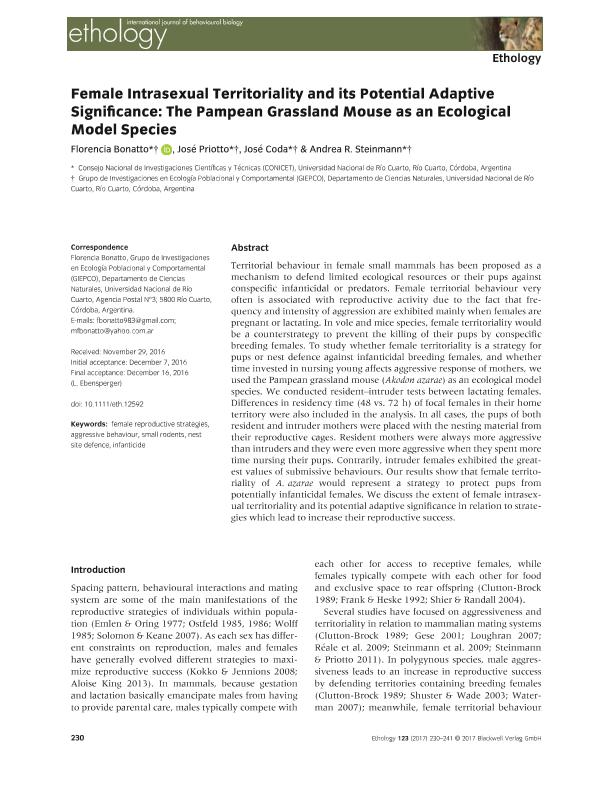Mostrar el registro sencillo del ítem
dc.contributor.author
Bonatto, Maria Florencia

dc.contributor.author
Priotto, Jose Waldemar

dc.contributor.author
Coda, José Antonio

dc.contributor.author
Steinmann, Andrea Rosa

dc.date.available
2019-03-21T22:50:40Z
dc.date.issued
2017-03
dc.identifier.citation
Bonatto, Maria Florencia; Priotto, Jose Waldemar; Coda, José Antonio; Steinmann, Andrea Rosa; Female Intrasexual Territoriality and its Potential Adaptive Significance: The Pampean Grassland Mouse as an Ecological Model Species; Wiley Blackwell Publishing, Inc; Ethology; 123; 3; 3-2017; 230-241
dc.identifier.issn
0179-1613
dc.identifier.uri
http://hdl.handle.net/11336/72276
dc.description.abstract
Territorial behaviour in female small mammals has been proposed as a mechanism to defend limited ecological resources or their pups against conspecific infanticidal or predators. Female territorial behaviour very often is associated with reproductive activity due to the fact that frequency and intensity of aggression are exhibited mainly when females are pregnant or lactating. In vole and mice species, female territoriality would be a counterstrategy to prevent the killing of their pups by conspecific breeding females. To study whether female territoriality is a strategy for pups or nest defence against infanticidal breeding females, and whether time invested in nursing young affects aggressive response of mothers, we used the Pampean grassland mouse (Akodon azarae) as an ecological model species. We conducted resident–intruder tests between lactating females. Differences in residency time (48 vs. 72 h) of focal females in their home territory were also included in the analysis. In all cases, the pups of both resident and intruder mothers were placed with the nesting material from their reproductive cages. Resident mothers were always more aggressive than intruders and they were even more aggressive when they spent more time nursing their pups. Contrarily, intruder females exhibited the greatest values of submissive behaviours. Our results show that female territoriality of A. azarae would represent a strategy to protect pups from potentially infanticidal females. We discuss the extent of female intrasexual territoriality and its potential adaptive significance in relation to strategies which lead to increase their reproductive success.
dc.format
application/pdf
dc.language.iso
eng
dc.publisher
Wiley Blackwell Publishing, Inc

dc.rights
info:eu-repo/semantics/openAccess
dc.rights.uri
https://creativecommons.org/licenses/by-nc-sa/2.5/ar/
dc.subject
Aggressive Behaviour
dc.subject
Female Reproductive Strategies
dc.subject
Infanticide
dc.subject
Nest Site Defence
dc.subject
Small Rodents
dc.subject.classification
Otras Ciencias Biológicas

dc.subject.classification
Ciencias Biológicas

dc.subject.classification
CIENCIAS NATURALES Y EXACTAS

dc.title
Female Intrasexual Territoriality and its Potential Adaptive Significance: The Pampean Grassland Mouse as an Ecological Model Species
dc.type
info:eu-repo/semantics/article
dc.type
info:ar-repo/semantics/artículo
dc.type
info:eu-repo/semantics/publishedVersion
dc.date.updated
2019-03-21T14:12:53Z
dc.journal.volume
123
dc.journal.number
3
dc.journal.pagination
230-241
dc.journal.pais
Reino Unido

dc.journal.ciudad
Londres
dc.description.fil
Fil: Bonatto, Maria Florencia. Universidad Nacional de Río Cuarto; Argentina. Consejo Nacional de Investigaciones Científicas y Técnicas; Argentina
dc.description.fil
Fil: Priotto, Jose Waldemar. Universidad Nacional de Río Cuarto; Argentina. Consejo Nacional de Investigaciones Científicas y Técnicas; Argentina
dc.description.fil
Fil: Coda, José Antonio. Universidad Nacional de Río Cuarto; Argentina. Consejo Nacional de Investigaciones Científicas y Técnicas; Argentina
dc.description.fil
Fil: Steinmann, Andrea Rosa. Universidad Nacional de Río Cuarto; Argentina. Consejo Nacional de Investigaciones Científicas y Técnicas; Argentina
dc.journal.title
Ethology

dc.relation.alternativeid
info:eu-repo/semantics/altIdentifier/doi/http://dx.doi.org/10.1111/eth.12592
dc.relation.alternativeid
info:eu-repo/semantics/altIdentifier/url/https://onlinelibrary.wiley.com/doi/abs/10.1111/eth.12592
Archivos asociados
